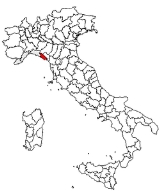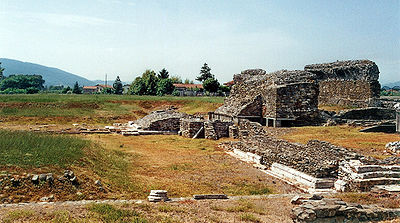
Luni, Italy
Encyclopedia


Frazione
A frazione , in Italy, is the name given in administrative law to a type of territorial subdivision of a comune; for other administrative divisions, see municipio, circoscrizione, quartiere...
of the comune
Comune
In Italy, the comune is the basic administrative division, and may be properly approximated in casual speech by the English word township or municipality.-Importance and function:...
(municipality) of Ortonovo
Ortonovo
Ortonovo is a comune in the Province of La Spezia in the Italian region Liguria, located about 100 km southeast of Genoa and about 20 km east of La Spezia....
, province of La Spezia
Province of La Spezia
The Province of La Spezia is a province in the Liguria region of Italy. Its capital is the city of La Spezia.It has an area of 881 km², and a total population of 223,606 inhabitants...
, in the easternmost end of the Liguria
Liguria
Liguria is a coastal region of north-western Italy, the third smallest of the Italian regions. Its capital is Genoa. It is a popular region with tourists for its beautiful beaches, picturesque little towns, and good food.-Geography:...
region of northern Italy
Italy
Italy , officially the Italian Republic languages]] under the European Charter for Regional or Minority Languages. In each of these, Italy's official name is as follows:;;;;;;;;), is a unitary parliamentary republic in South-Central Europe. To the north it borders France, Switzerland, Austria and...
. It gives its name to Lunigiana
Lunigiana
The Lunigiana is an historical territory of Italy, which today falls within the provinces of La Spezia and Massa Carrara. Its borders derive from the ancient Roman settlement, later the medieval diocese of Luni, which no longer exists....
, a region spanning eastern Liguria and northern Tuscany
Tuscany
Tuscany is a region in Italy. It has an area of about 23,000 square kilometres and a population of about 3.75 million inhabitants. The regional capital is Florence ....
(province of Massa-Carrara
Province of Massa-Carrara
The Province of Massa and Carrara , until 2009 Province of Massa-Carrara, is a province in the Tuscany region of Italy. It is named after the two main towns in its territory: Carrara and Massa, its capital.-History:...
).
Geography
Points of interest include remains of the elliptical Roman amphitheatreAmphitheatre
An amphitheatre is an open-air venue used for entertainment and performances.There are two similar, but distinct, types of structure for which the word "amphitheatre" is used: Ancient Roman amphitheatres were large central performance spaces surrounded by ascending seating, and were commonly used...
(1st century AD) and the Archaeological Museum.
History
Founded by the RomansAncient Rome
Ancient Rome was a thriving civilization that grew on the Italian Peninsula as early as the 8th century BC. Located along the Mediterranean Sea and centered on the city of Rome, it expanded to one of the largest empires in the ancient world....
in 177 BC
177 BC
Year 177 BC was a year of the pre-Julian Roman calendar. At the time it was known as the Year of the Consulship of Pulcher and Gracchus...
with the name Luna, at the mouth of the Magra
Magra
The Magra is a 62 km river of Northern Italy, which runs through Pontremoli, Villafranca in Lunigiana and Aulla in the province of Massa-Carrara ; Santo Stefano di Magra, Vezzano Ligure, Arcola, Sarzana and Ameglia in the province of La Spezia .In Roman times it was known as the Macra and marked...
, it was a military stronghold for the campaigns against the Ligures
Ligures
The Ligures were an ancient people who gave their name to Liguria, a region of north-western Italy.-Classical sources:...
: there is an inscription in the Archaeological Museum from the base of a triumphal column erected in the second consulate of C. Claudius Marcellus to commemorate the repression of the last rebellion of the Ligures. In 109 BC it was connected to Rome by the Via Aemilia Scauri
Via Aemilia Scauri
The Via Aemilia Scauri was an ancient Roman road built by the Consul Marcus Aemilius Scaurus in 115 BCE.- Route :It is mainly a coastal road, doubling Via Aurelia, and connecting Rome to Placentia and Pisa, passing through Genoa...
, rebuilt in the 2nd century AD as the Via Aurelia
Via Aurelia
The Via Aurelia was a Roman road in Italy constructed around the year 241 BC. The project was undertaken by C. Aurelius Cotta, who at that time was censor...
. It flourished when exploitation of white marble quarries in the nearby Alpi Apuane
Alpi Apuane
The Alpi Apuane are a mountain range in northern Tuscany, Italy, part of the Apennine Mountains. They are included between the valleys of the Serchio and Magra rivers, and, to north-west, the Garfagnana and Lunigiana...
began in the 1st century BC and soon owned by the imperial family.
Pliny the Elder
Pliny the Elder
Gaius Plinius Secundus , better known as Pliny the Elder, was a Roman author, naturalist, and natural philosopher, as well as naval and army commander of the early Roman Empire, and personal friend of the emperor Vespasian...
considered the big wheels of cheese from Luna the best in Etruria
Etruria
Etruria—usually referred to in Greek and Latin source texts as Tyrrhenia—was a region of Central Italy, an area that covered part of what now are Tuscany, Latium, Emilia-Romagna, and Umbria. A particularly noteworthy work dealing with Etruscan locations is D. H...
.
In the 5th century AD it was still notable, as it was chosen as episcopal see
Episcopal See
An episcopal see is, in the original sense, the official seat of a bishop. This seat, which is also referred to as the bishop's cathedra, is placed in the bishop's principal church, which is therefore called the bishop's cathedral...
. Captured by the Goths in the following century, it was reconquered by the Byzantines
Byzantine Empire
The Byzantine Empire was the Eastern Roman Empire during the periods of Late Antiquity and the Middle Ages, centred on the capital of Constantinople. Known simply as the Roman Empire or Romania to its inhabitants and neighbours, the Empire was the direct continuation of the Ancient Roman State...
in 552, who however lost it to the Lombards
Lombards
The Lombards , also referred to as Longobards, were a Germanic tribe of Scandinavian origin, who from 568 to 774 ruled a Kingdom in Italy...
in 642. The latter damaged the city's economy, favouring the trades routes that passed through the nearby port of Lucca
Lucca
Lucca is a city and comune in Tuscany, central Italy, situated on the river Serchio in a fertile plainnear the Tyrrhenian Sea. It is the capital city of the Province of Lucca...
to the south. Luni had reduced to a small village at the time of the Lombard king Liutprand
Liutprand, King of the Lombards
Liutprand was the King of the Lombards from 712 to 744 and is chiefly remembered for his Donation of Sutri, in 728, and his long reign, which brought him into a series of conflicts, mostly successful, with most of Italy. He profited by Byzantine weakness to enlarge his domains in Emilia and the...
, later, it was a countship see under Charlemagne
Charlemagne
Charlemagne was King of the Franks from 768 and Emperor of the Romans from 800 to his death in 814. He expanded the Frankish kingdom into an empire that incorporated much of Western and Central Europe. During his reign, he conquered Italy and was crowned by Pope Leo III on 25 December 800...
, exactly on the border between the Kingdom of Italy
Kingdom of Italy (medieval)
The Kingdom of Italy was a political entity under control of Carolingian dynasty of Francia first, after the defeat of the Lombards in 774. It was finally incorporated as a part of the Holy Roman Empire in 962....
and the Papal States
Papal States
The Papal State, State of the Church, or Pontifical States were among the major historical states of Italy from roughly the 6th century until the Italian peninsula was unified in 1861 by the Kingdom of Piedmont-Sardinia .The Papal States comprised territories under...
.
It was repeatedly sacked by sea pirates, Saracens in 849 and Normans
Normans
The Normans were the people who gave their name to Normandy, a region in northern France. They were descended from Norse Viking conquerors of the territory and the native population of Frankish and Gallo-Roman stock...
in 860. In the mid 10th century it experienced the last period of splendour under count Oberto I
Oberto I
Oberto I Obizzo was an Italian count palatine and margrave and the oldest known member of the Obertenghi family. He was, by heredity, Count of Milan from 951...
, who was lord of the whole Ligurian Mark, and momentarily repulsed the pirate threat. However, in the 990s the situation worsened again, and the episcopal see was moved, first to Carrara
Carrara
Carrara is a city and comune in the province of Massa-Carrara , notable for the white or blue-grey marble quarried there. It is on the Carrione River, some west-northwest of Florence....
then, definitively, to Sarzana
Sarzana
Sarzana is a town and comune in the Province of La Spezia, of Liguria, Italy, 15 km east of Spezia, on the railway to Pisa, at the point where the railway to Parma diverges to the north...
in 1207. In 1015 Luna was conquered by the Andalusian emir of Denia
Taifa of Dénia
The taifa of Dénia was a Muslim kingdom in medieval Spain, ruling over part of the Valencian coast and Ibiza. With Dénia as its capital, the taifa included the Balearic Islands and parts of the Spanish mainland.- History :...
, Mujāhid with his Sardinian ships: when Pisa and Genoa beat back his forces
Pisan–Genoese expeditions to Sardinia (1015–1016)
In 1015 and again in 1016 forces from the taifa of Denia, in the east of Muslim Spain , attacked Sardinia and attempted to establish control over it. In both these years joint expeditions from the maritime republics of Pisa and Genoa repulsed the invaders and preserved Sardinia as a part of...
, Luni was left destroyed. The spreading of malaria in the area and the silting up of the port contributed to the steep decline of Luni. In 1058 the whole population moved to Sarzana, while other refugees founded Ortonovo
Ortonovo
Ortonovo is a comune in the Province of La Spezia in the Italian region Liguria, located about 100 km southeast of Genoa and about 20 km east of La Spezia....
and Nicola. The title of bishop and count of Luni remained in use for various centuries, but Petrarch
Petrarch
Francesco Petrarca , known in English as Petrarch, was an Italian scholar, poet and one of the earliest humanists. Petrarch is often called the "Father of Humanism"...
noted Luni as "once famous and powerful and now only a naked and useless name".
The Latin legend of the Volto Santo of Lucca, De inventione, revelatione ac tranlatione Sanctissimi Vultu, makes insistent points through miraculous interventions that the crucifix belonged rightfully at Lucca, offering the suggestion that it had previously been at Luni and that its removal required marks of heavenly approval.
It was only in 1442 that the highly visible remains were identified with Luni and the Gulf of La Spezia recognized as its harbour. The depredation of the Roman ruins of Luni aroused the concern of the local Cardinal Filippo Calandrini, who urged the Humanist pope Pius II
Pope Pius II
Pope Pius II, born Enea Silvio Piccolomini was Pope from August 19, 1458 until his death in 1464. Pius II was born at Corsignano in the Sienese territory of a noble but decayed family...
to issue a brief (7 April 1461) forbidding any further dilapidations. It was of little practical use: when the Palazzo del Commune of Sarzana was constructed in 1471 dressed stone from Luni supplied a considerable part of the building material. In 1510 the city council of Sarzana made a gift to the French governor at Genoa of a marble triton found at Luni.

